.jpg.webp)
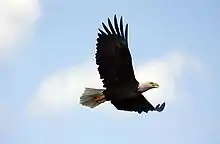
Over 500 bald eagle utilize the region's wetlands for foraging between November and April,[1] especially under the protection within the Bear Valley National Wildlife Refuge.
The following bird species are found in the Klamath Basin, Oregon, and related areas; (a few species listed are only "native" and have a larger continental range). The Klamath Basin is within the Pacific Flyway so, over 350 species can be spotted migrating through the flyover.[1]
| Group | Common name | Scientific name | Features | Image |
|---|---|---|---|---|
| Dippers | American dipper | Cinclus mexicanus |  | |
| Thrushes, bluebirds and solitaires | American robin | Turdus migratorius | A resident species frequently seen in towns and lawns. | 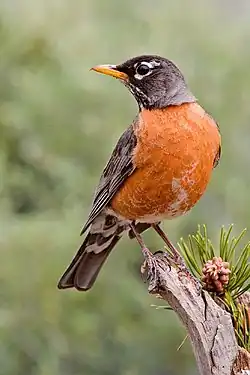 |
| Western bluebird | Sialia mexicana | Uncommonly observed but known to breed in the Klamath Basin | 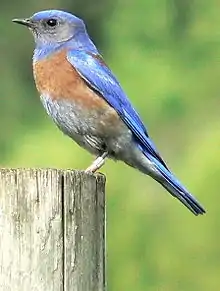 | |
| Mountain bluebird | Sialia currucoides | Resident species | 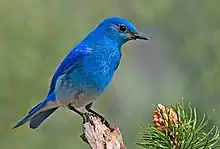 | |
| Townsend's solitaire | Myadestes townsendi | Commonly observed; sighting likelihood good in appropriate habitat especially in the fall and winter. Known to breed in the Klamath Basin |  | |
| Swainson's thrush | Catharus ustulatus | Rarely observed, mostly in the spring through the fall; unlikely to be seen even in appropriate habitat but known to breed in the Klamath Basin | 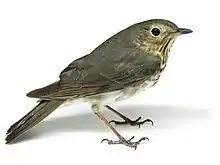 | |
| Hermit thrush | Catharus guttatus | Uncommonly observed but known to breed in the Klamath Basin |  | |
| Varied thrush | Ixoreus naevius or Zoothera naevia | Rarely observed, mostly in the fall and winter; unlikely to be seen even in appropriate habitat but known to breed in the Klamath Basin | 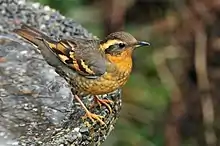 | |
| Anna's hummingbird | Calypte anna |  | ||
| Ash-throated flycatcher | Myiarchus cinerascens |  | ||
| Barn swallow | Hirundo rustica | |||
| Bewick's wren | Thryomanes bewickii | 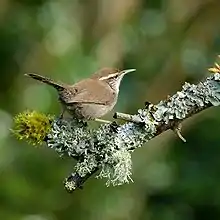 | ||
| Black-headed grosbeak | Pheucticus melanocephalus |  | ||
| Brewer's blackbird | Euphagus cyanocephalus |  | ||
| Brewer's sparrow | Spizella breweri |  | ||
| Brown-headed cowbird |  | |||
| California quail | 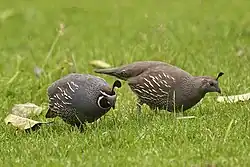 | |||
| California towhee | ||||
| Calliope hummingbird | Stellula calliope |  | ||
| Canada goose | Branta canadensis |  | ||
| Canyon wren | Catherpes mexicanus |  | ||
| Cassin's finch | Carpodacus cassinii | .jpg.webp) | ||
| Chipping sparrow | Spizella passerina | 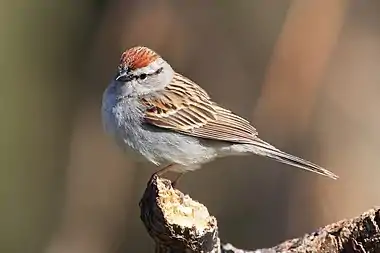 | ||
| Clark's nutcracker | Nucifraga columbiana | 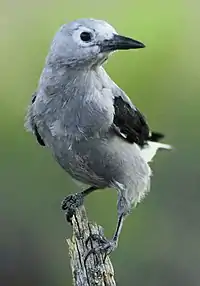 | ||
| Common loon | Gavia immer | Uncommonly observed, mostly in the spring and then in the fall | 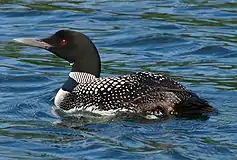 | |
| Common nighthawk | Chordeiles minor | 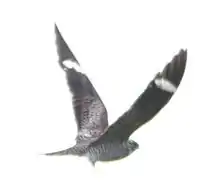 | ||
| Common raven | Corvus corax | 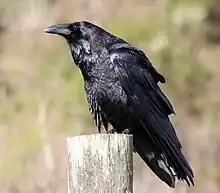 | ||
| Fox sparrow | Passerella iliaca | 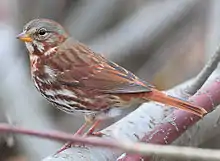 | ||
| Golden-crowned sparrow | Zonotrichia atricapilla | 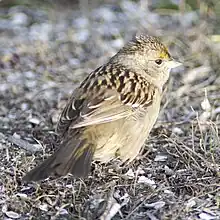 | ||
| Green-tailed towhee | Pipilo chlorurus | 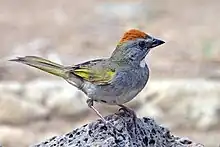 | ||
| Great blue heron | Ardea herodias |  | ||
| Horned lark | Eremophila alpestris | Resident species | 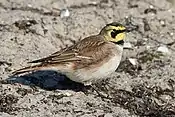 | |
| House finch | Carpodacus mexicanus |  | ||
| House wren | Troglodytes aedon | Resident species |  | |
| Juniper titmouse | Baeolophus ridgwayi |  | ||
| Lazuli bunting | Passerina amoena | Migrant species | 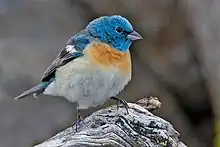 | |
| Lewis's woodpecker | Melanerpes lewis | 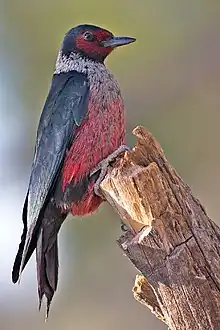 | ||
| Loggerhead shrike | Lanius ludovicianus | Resident species |  | |
| Mountain chickadee | Poecile gambeli |  | ||
| Mourning dove | Zenaida macroura |  | ||
| Northern flicker | Colaptes auratus | 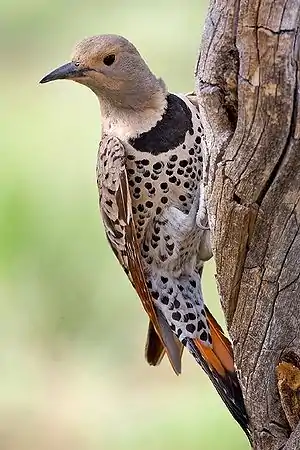 | ||
| Northern mockingbird | Mimus polyglottos | |||
| Olive-sided flycatcher | Contopus cooperi | Migrant species | 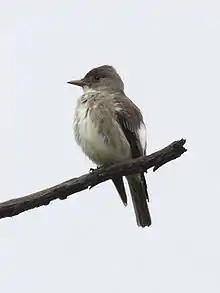 | |
| Pacific loon | Gavia pacifica | Rarely observed, mostly in the spring and then in the fall; unlikely to be seen even in appropriate habitat | ||
| Pygmy nuthatch | Sitta pygmaea | _at_a_feeder.jpg.webp) | ||
| Red-breasted nuthatch | Sitta canadensis | A permanent resident and an acrobatic species, hitching itself up and down tree trunks and branches.[2] | 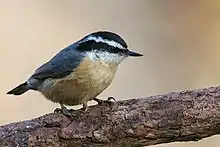 | |
| Red crossbill | Loxia curvirostra | Migrant species | .jpg.webp) | |
| Red-naped sapsucker | Sphyrapicus nuchalis | Migrant species | 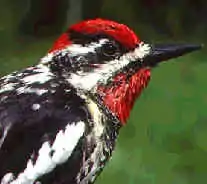 | |
| Common pheasant | Phasianus colchicus | .jpg.webp) | ||
| Red-tailed hawk | Buteo jamaicensis | 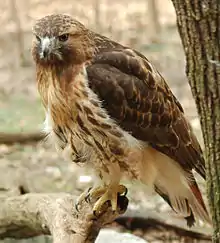 | ||
| Red-winged blackbird | Agelaius phoeniceus | Resident species |  | |
| Sage grouse | Centrocercus urophasianus | .jpg.webp) | ||
| Sage sparrow | Amphispiza belli | 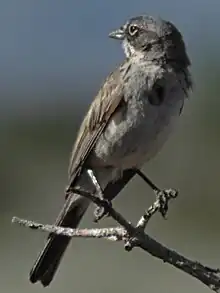 | ||
| Sage thrasher | Oreoscoptes montanus | Resident species |  | |
| Savannah sparrow | Passerculus sandwichensis | 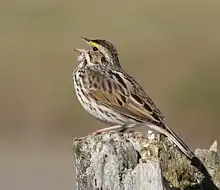 | ||
| Song sparrow | Melospiza melodia |  | ||
| Spotted towhee | Pipilo maculatus |  | ||
| Common starling | Sturnus vulgaris | Non-native species, common in widespread areas of the Upper Klamath Basin. |  | |
| Turkey vulture | Cathartes aura | 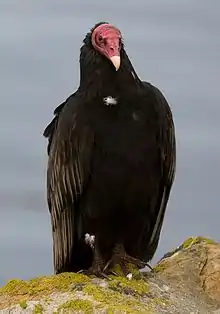 | ||
| Western meadowlark | Sturnella neglecta | A resident and the official state bird of Oregon and other 5 US states. |  | |
| Western tanager | Piranga ludoviciana |  | ||
| Western wood pewee | Contopus sordidulus | 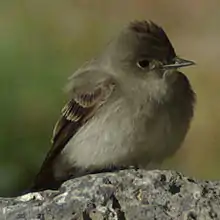 | ||
| White-breasted nuthatch | Sitta carolinensis | 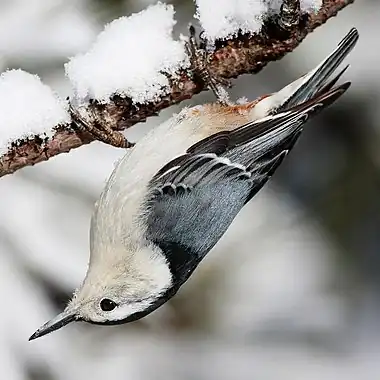 | ||
| White-crowned sparrow | Zonotrichia leucophrys | 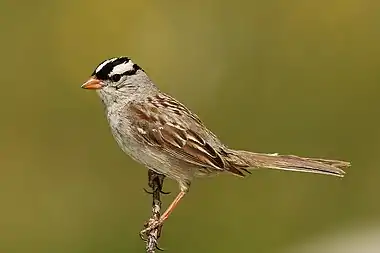 | ||
| White-faced ibis | Plegadis chihi | 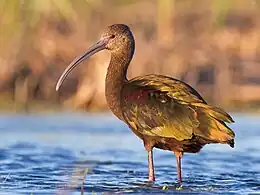 | ||
| White-headed woodpecker | Picoides albolarvatus | Resident species | 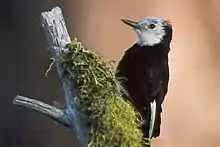 | |
| Yellow warbler | Dendroica petechia | A migrant species that lives in the basin during the spring and summer.[3] | 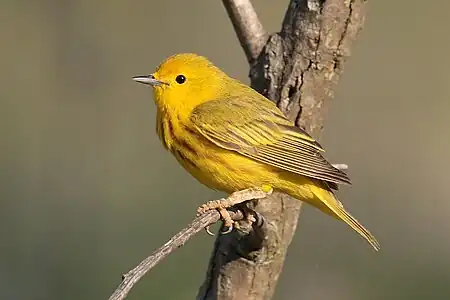 | |
See also
References
- 1 2 Klamath Basin Birding Trail Presented by Klamath Basin Wingwatchers organization.
- ↑ Dunn, Jon L.; Alderfer, Jonathan, eds. (2006). National Geographic Field Guide to the Birds of North America (5 ed.). Washington DC: National Geographic. p. 341. ISBN 0-7922-5314-0.
- ↑ Birds of the Basins by the Bureau of Land Management, Lakeview District; the Fremont National Forest; and the Klamath Basin Ecosystem Restoration.
This article is issued from Wikipedia. The text is licensed under Creative Commons - Attribution - Sharealike. Additional terms may apply for the media files.